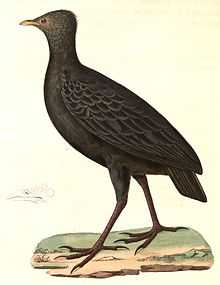Dusky megapode
| Dusky megapode | |
|---|---|
 | |
| Conservation status | |
| Scientific classification | |
| Kingdom: | Animalia |
| Phylum: | Chordata |
| Class: | Aves |
| Order: | Galliformes |
| Family: | Megapodiidae |
| Genus: | Megapodius |
| Species: | M. freycinet |
| Binomial name | |
| Megapodius freycinet Gaimard, 1823 | |
| Subspecies | |
The dusky megapode or dusky scrubfowl (Megapodius freycinet) is a medium-sized (about 41-cm-long), blackish bird with a short pointed crest, bare red facial skin, dark legs, brown irises, and dark brown and yellow bill. The male and female are similar. This terrestrial species lives in forests and swamps, including mangroves, of the Maluku and Raja Ampat Islands in Indonesia. Like other megapodes, it lays its eggs in a mound made from earth mixed with leaves, sand, gravel, and sticks.
Many authorities include the Biak scrubfowl as a subspecies of this species, but the two are increasingly treated as separate species. At the same time, many authorities consider the taxon M. forstenii a separate species, Forsten's megapode, but measurements and molecular evidence suggests the two are very close,[2] and arguably better considered conspecific. Traditionally, most members of the genus Megapodius have been listed as subspecies of M. freycinet, but today all major authorities consider this incorrect.
The specific name commemorates the French explorer Louis Claude Desaulses de Freycinet.
A fairly common species throughout a large part of its range, the dusky scrubfowl is evaluated as Least Concern on the IUCN Red List of Threatened Species.
References
- ↑ BirdLife International (2013). "Megapodius freycinet". IUCN Red List of Threatened Species. Version 2013.2. International Union for Conservation of Nature. Retrieved 26 November 2013.
- ↑ Birks, S. M., & Edwards, S. V. (2002). A phylogeny of the megapodes (Aves: Megapodidae) based on nuclear and mitochondrial DNA sequences. Molecular Phylogenetics and Evolution 23: 408-421.
